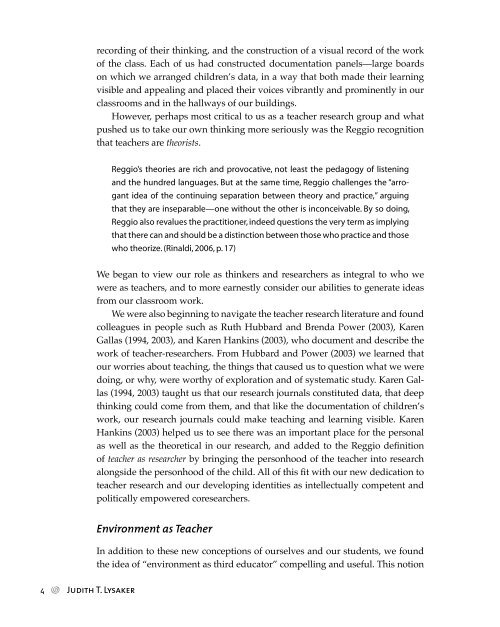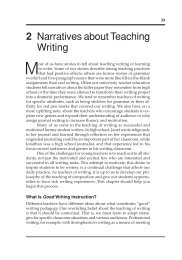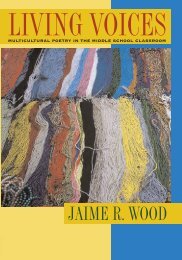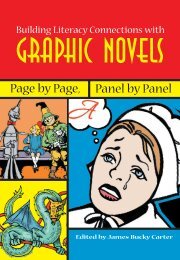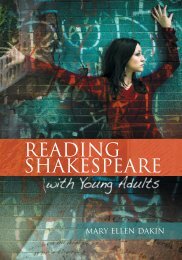View a Sample Chapter - National Council of Teachers of English
View a Sample Chapter - National Council of Teachers of English
View a Sample Chapter - National Council of Teachers of English
- No tags were found...
Create successful ePaper yourself
Turn your PDF publications into a flip-book with our unique Google optimized e-Paper software.
ecording <strong>of</strong> their thinking, and the construction <strong>of</strong> a visual record <strong>of</strong> the work<strong>of</strong> the class. Each <strong>of</strong> us had constructed documentation panels—large boardson which we arranged children’s data, in a way that both made their learningvisible and appealing and placed their voices vibrantly and prominently in ourclassrooms and in the hallways <strong>of</strong> our buildings.However, perhaps most critical to us as a teacher research group and whatpushed us to take our own thinking more seriously was the Reggio recognitionthat teachers are theorists.Reggio’s theories are rich and provocative, not least the pedagogy <strong>of</strong> listeningand the hundred languages. But at the same time, Reggio challenges the “arrogantidea <strong>of</strong> the continuing separation between theory and practice,” arguingthat they are inseparable—one without the other is inconceivable. By so doing,Reggio also revalues the practitioner, indeed questions the very term as implyingthat there can and should be a distinction between those who practice and thosewho theorize. (Rinaldi, 2006, p. 17)We began to view our role as thinkers and researchers as integral to who wewere as teachers, and to more earnestly consider our abilities to generate ideasfrom our classroom work.We were also beginning to navigate the teacher research literature and foundcolleagues in people such as Ruth Hubbard and Brenda Power (2003), KarenGallas (1994, 2003), and Karen Hankins (2003), who document and describe thework <strong>of</strong> teacher-researchers. From Hubbard and Power (2003) we learned thatour worries about teaching, the things that caused us to question what we weredoing, or why, were worthy <strong>of</strong> exploration and <strong>of</strong> systematic study. Karen Gallas(1994, 2003) taught us that our research journals constituted data, that deepthinking could come from them, and that like the documentation <strong>of</strong> children’swork, our research journals could make teaching and learning visible. KarenHankins (2003) helped us to see there was an important place for the personalas well as the theoretical in our research, and added to the Reggio definition<strong>of</strong> teacher as researcher by bringing the personhood <strong>of</strong> the teacher into researchalongside the personhood <strong>of</strong> the child. All <strong>of</strong> this fit with our new dedication toteacher research and our developing identities as intellectually competent andpolitically empowered coresearchers.Environment as TeacherIn addition to these new conceptions <strong>of</strong> ourselves and our students, we foundthe idea <strong>of</strong> “environment as third educator” compelling and useful. This notion4 D Judith T. Lysaker


